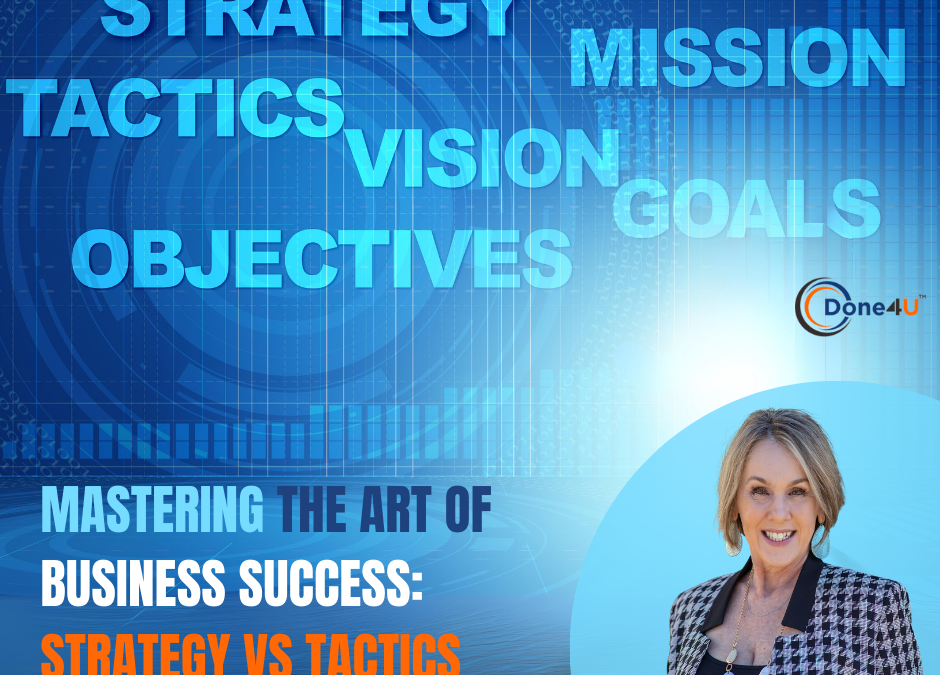Strategy vs. tactics? Which is more important to the growth of your business?
It’s kind of like the chicken or the egg, right?
The truth is strategy and tactics are both critical to your business success. There relationship is symbiotic.
Strategies without tactics in place to bring them to life are just ideas.
Tactics that aren’t based in strategies are like throwing spaghetti at the wall – let’s see what sticks.
Strategy vs. Tactics – Knowing When To Use Which
As a successful service-based small business owner, you understand the importance of making strategic decisions to propel your business forward. However, it can be challenging to determine when to employ a strategic approach and when to dive into tactical implementation to meet a specific goal. In this blog post, we will revisit the difference between strategy and tactics (it can get a bit murky at times), offering you clarity and guidance on when to use each of these business growth tools to achieve your business goals effectively.
For example, during a meeting with one of my clients, this subject came up. She asked if my company does website work. I said yes, I have a web developer on my team who designs and builds websites. She said, she didn’t want to revamp her entire website right now. What she does want is to update it to reflect the direction that she is headed in right now and to support the strategies she is planning to implement.
As the conversation unfolded, I learned that she has approached some colleagues with the same thought of updates to her website to gain some feedback and suggestions. She got more than what she asked for. She was advised to put an SEO plan in place, migrate from all her apps into the one app that the colleague uses, all of course for a fee. In other words, what started as an ask for ideas turned into a sales pitch to put specific strategies in place.
As it turned out, what my client wanted was tactics she could employ to carry out an existing strategy to reach the ultimate goals. The strategy the colleague offered was a good one. It just didn’t meet the needs of the moment or solve the problem. The timing wasn’t right. It was the time for tactics and not strategy.
As my client and I explored the situation a bit more, I was able to provide her with the tactics she needed. It was a feel good moment that we both appreciated.
When to Use Strategy
1. **Long-term Vision**: Use strategy when you need to define your business’s long-term vision. If you’re looking to expand your service offerings, enter new markets, or scale your business significantly, a strategic approach is essential. In fact, now is the time to plan next year’s strategies to meet next year’s goals and to revisit this year’s strategies to make sure they are still on point to close out this year with business growth success. Check out this informative McKinsey article for data around choosing and planning for business growth.
2. **Market Analysis**: Strategy is crucial when conducting researching the market. This includes understanding customer needs, knowing your competitors and what they are doing, and emerging trends to make informed decisions that can set your business apart.
3. **Resource Allocation**: Determine your budget, resource allocation, and investment decisions through strategic planning. This ensures that you’re making calculated investments that align with your business’s long-term goals. Do you need or want to invest in team in the upcoming year? Are their trainings or conferences you want to attend? Is this the year to get that certification you’ve been eyeballing for a while? Take my free Time & Money Saving Assessment here at the bottom of the homepage on my website to determine where you spend the most time in your business, how much money that’s costing you, and how much of a budget you can allocate toward a new team member.
4. **Brand Positioning**: When you want to establish a strong and differentiated brand identity, strategy is the key. Crafting your brand story, values, and unique selling propositions falls under strategic decision-making. Brand positioning isn’t a one and done deal because of the evolution of your ideal clients’ businesses as well as your own.
5. **Change Management**: When navigating significant changes like mergers, acquisitions, or restructuring, strategy helps you create a roadmap to guide the transition smoothly. This is not my area of expertise. However, if this is something you are considering, I know experts who do. Contact me for a connection.
When to Use Tactics
1. **Short-term Execution**: Tactics come into play when you’re ready to implement specific actions to achieve immediate goals. For example, if you’ve decided to run a limited-time promotional campaign to boost sales, tactics are what you need.
2. **Marketing Campaigns**: Designing and executing marketing campaigns, such as email marketing, social media advertising, or content creation, falls under tactical execution to achieve strategic marketing goals.
3. **Customer Engagement**: Tactics are ideal for daily customer interactions, like responding to inquiries, handling complaints, or providing customer support. This also applies to potential customer engagement, especially if you have a team member implementing this.
4. **Product Development**: If you’re introducing a new product or service, tactics are crucial in the development process, ensuring that it aligns with your strategic vision and supports the short- and long-term growth of your business.
5. **Data Analysis and Optimization**: I am a firm believer in data tracking and analysis. I do it for most of my clients. How else are you going to measure what’s working and what’s not? Tactical decision-making is essential when analyzing data and making adjustments in real-time. For instance, A/B testing to optimize website conversion rates is a tactical approach to enhance the user experience.
Next Steps to Achieve Business Goals
Now that you understand the distinction between strategy and tactics and when to use each, here are the next steps to help you reach your business goals effectively:
1. **Set Clear Objectives**: Begin by defining your business objectives. What do you want to achieve in the short term and long term? Having clear goals will guide your decision-making.
2. **Align Strategy and Tactics**: Ensure that your tactical actions directly support your strategic goals. Each tactic should have a clear connection to your overarching strategy.
3. **Regularly Review and Adapt**: Business environments change quickly, and so should your strategies and tactics. Regularly review your progress, analyze data, and be prepared to adapt as needed.
4. **Invest in Skill Development**: Both strategy and tactics require skill sets. Invest in your own skills or those of your team to make informed decisions and execute effectively.
5. **Measure Results**: Establish key performance indicators (KPIs) to measure the success of your tactics in achieving strategic objectives. Data-driven decision-making is invaluable.
Conclusion
In the ever-evolving landscape of small business ownership, knowing when to use strategy and tactics is crucial to success. While strategy defines the long-term vision and direction of your business, tactics are the actionable steps that bring your vision to life. By understanding the clear distinction between the two and applying them strategically, you’ll be well-equipped to navigate the challenges and opportunities that lie ahead, ensuring your continued growth and prosperity.



Trackbacks/Pingbacks